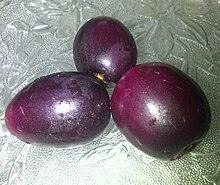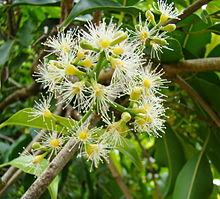Syzygium cumini
| Syzygium cumini | ||||||||||||
|---|---|---|---|---|---|---|---|---|---|---|---|---|

Syzygium cumini , illustration |
||||||||||||
| Systematics | ||||||||||||
|
||||||||||||
| Scientific name | ||||||||||||
| Syzygium cumini | ||||||||||||
| ( L. ) Skeels |
Syzygium cumini (L.) Skeels ( Syn .: syzygium jambolana (Lam.) DC. , Eugenia jambolana Lam. , Myrtus cumini L. , Eugenia cumini (L.) Druce ) occasionally Jambulbaum , Jambolanapflaume , rose apple or Wachsjambuse called, is a deciduous tree species from the family of the myrtle family (Myrtaceae). It is cultivated in the tropics for its edible fruits and for medicinal purposes.
description
Syzygium cumini is an evergreen deciduous tree that reaches heights of about 6 to 20, occasionally up to 25 m. As a very fast growing tree, it will have reached its final height after about 40 years. The crown is up to 11 m wide, the trunk reaches a diameter of 60 to 90 cm and often branches into several main branches just above the ground. The wood is reddish to gray-brown with a fine grain. The bark is gray and smooth on younger branches, later it becomes brownish, rough and dissolves in scales. Underneath there is a second, thick and fibrous layer of bark .
Syzygium cumini has opposite, ovate to elliptical or obovate and whole-margined leaves that are 3.5 to 7 cm wide and 6 to 12 (–17) cm long, plus the 1 to 2 cm long petiole. The base of the leaf is usually pointed to blunt, it is rarely rounded, the tip of the leaf is rounded or round-pointed to pointed. The leaves give off a turpentine odor. They are leathery, reddish when budding, later dark green on the top and lighter on the underside. The veins are finely pinnate with many fine side veins.
The flowering period is rich from February to May. The zymose , up to 11 cm large and paniculate inflorescences are axillary, rarely terminal. The yellow-white, small flowers with a double flower envelope consist of a 4 to 8 mm large flower cup , the free sepal tips are minimal. The four sloping, kalyptraten and small petals are white or pink, egg-shaped to round and about 2.5 mm in size. There are many, longer stamens . The two-chamber ovary is inferior with a long, solid pen and minimal scar .
The shiny, smooth and small fruits with small remains of the flower cups turn red to black during the ripening period, which extends from June to September. They are round to ovoid and 1 to 2 cm in size. The fruits usually contain only one, rarely up to five beige seeds. The pulp can be whitish to red in color.
The number of chromosomes is 2n = 66.

Occurrence
The distribution area of Syzygium cumini extends from India and Sri Lanka to the east over the Malay Peninsula and southern China to northeastern Australia . The species was cultivated and distributed early on, so that its occurrence in the Philippines, Java and other islands of the Malay Archipelago as far as Australia can be traced back to human spread. Is grown Syzygium cumini now also including in the West Indies ( Caribbean Islands ), Florida and Mauritius .
Syzygium cumini colonizes the edges of rivers and is also found in disturbed forests and in ruderal places. The species occurs up to an altitude of 1200 meters.
use
The pulp has a sour to sweet taste and astringent ( astringency ). Suitable varieties can be consumed raw as fruit or processed. Juice, wine, spirits and vinegar are produced from the fruits.
The wood is a little difficult to dry and work with, but then it is durable and is used as construction wood.
An essential oil for making perfumes is extracted from the leaves .
The bark is used for tanning due to the tannin content of 8 to 19%. It also provides a brown dye.
Syzygium cumini is one of the most widely used plants in the Asia-Pacific region for the prevention and treatment of diabetes mellitus in traditional medicine. In addition to leaves and bark, fruits and seeds are primarily used medicinally. In Europe, Syzygium was a component of antidiabetic drugs as early as the beginning of the 20th century and was found in medical-pharmaceutical reference works as early as the turn of the century. In Germany, the plant is best known in homeopathic use by its popular name "Jambulbaum".
The preparations from the seeds are used for the adjuvant therapy of diabetes. Animal studies were carried out with the extracts, but clinical studies based on modern criteria are still lacking.
Systematics
Carl von Linné already described this species in 1753 as Myrtus cumini in the first volume of his work " Species Plantarum ". The assignment to the genus Syzygium was made by Homer Collar Skeels in 1912. The "Flora of China" names Syzygium cumini var. Tsoi as a variety that occurs in the Guangxi Autonomous Region and on Hainan .
Individual evidence
- ↑ a b c d e f g Jie Chen, Lyn A. Craven: Myrtaceae . In: Wu Zhengyi, Peter H. Raven, Hong Deyuan (eds.): Flora of China . tape 13 , 2007, p. 355 ( efloras.org ).
- ↑ a b c B. Verdcourt: Syzygium cumini . In: Flora of Tropical East Africa . 2001 ( plants.jstor.org ).
- ↑ a b c d e Julia F. Morton: Fruits of warm climates . Miami 1987, p. 375-378 ( Purdue University ).
- ^ Syzygium cumini at Tropicos.org. In: IPCN Chromosome Reports . Missouri Botanical Garden, St. Louis.
- ^ A. Ghani: Medicinal Plants of Bangladesh with Chemical Constituents and Uses . Ed .: Dhaka: Asiatic Society of Bangladesh. Berlin, Heidelberg 2003, p. 637-638 ( vedamsbooks.com ).
- ^ CP Khare: Medicinal Plants of Bangladesh with Chemical Constituents and Uses . Ed .: Springer. 2007, p. 397 ( books.google.de ).
- ↑ M. Ayyanar, P. Subash-Babu: Syzygium Cumini (L.) Skeels: A Review of its Phytochemical Constituents and Traditional Uses . In: Asian Pac. J. Trop. Biomed. 2, 2012, 240–246, PMC 3609276 (free full text).
- ↑ M. Ayyanar, P. Subash-Babu, S. Ignacimuthu: Syzygium Cumini (L.) Skeels., A Novel Therapeutic Agent for Diabetes: Folk Medicinal and Pharmacological Evidences . In: Complement Ther Med. 21, 2013, 232-243.
- ↑ Ocvirk, M. Kistler, S. Khan, SH Talukder, H. Hauner: Traditional Medicinal Plants Used for the Treatment of Diabetes in Rural and Urban Areas of Dhaka, Bangladesh - to Ethnobotanical Survey. In: J Ethnobiol Ethnomed . 9, 2013, 43, PMC 3702453 (free full text).
- ↑ Positive monograph of Commission D of the BGA / BfArM for Syzygium cumini as an additive for diabetes. on medicinal plants world .
- ↑ A. Helmstädter: Syzygium Cumini (L.) Skeels (Myrtaceae) against Diabetes - 125 Years of Research In: Pharmazie. 63 (2), 2008, 91-101.
Web links
- Entry on Syzygium cumin at plants.jstor.org.
- Syzygium cumini at Pitchandikulam Forest Virtual Herbarium.
- Syzygium cumini at Useful Tropical Plants.
